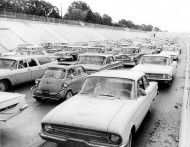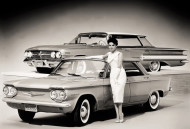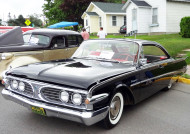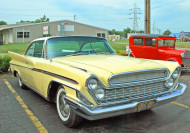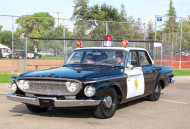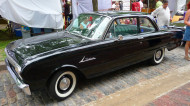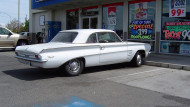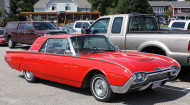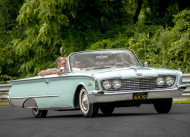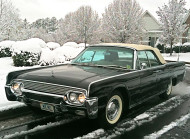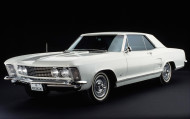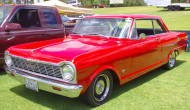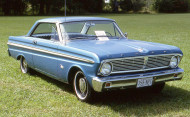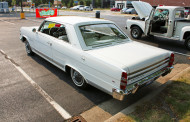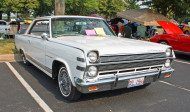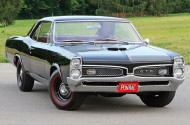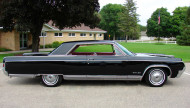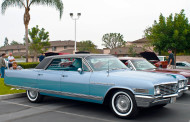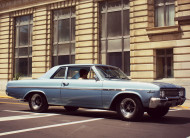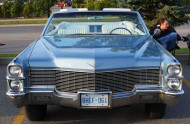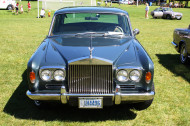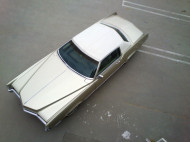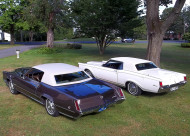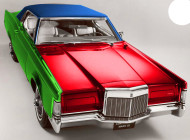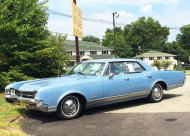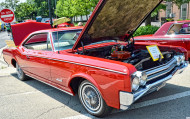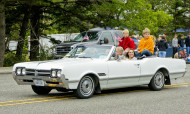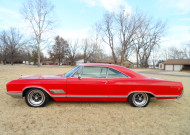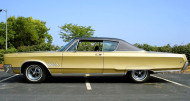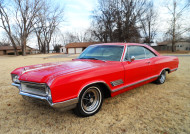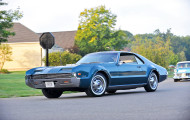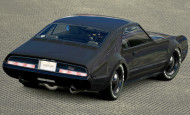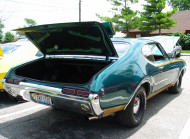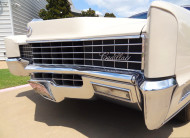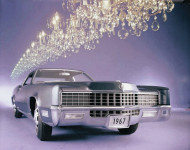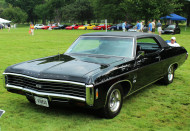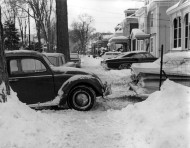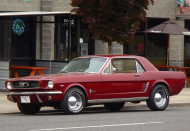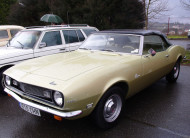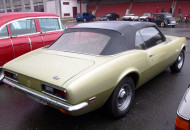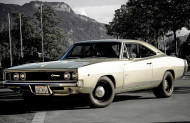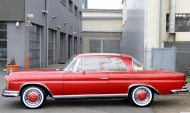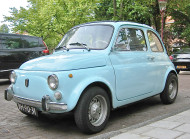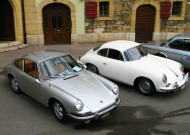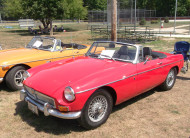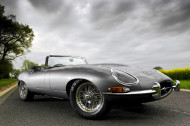CONTINUED FROM PART 1…
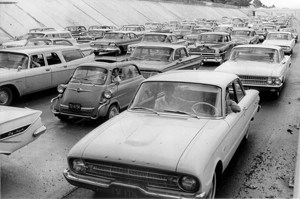 (Attempting to resolve a debate with my mother that cars from the late 1940s and ’50s on any given street were more recognizable than now, I take a look at some of the more popular design trends during different decades. This installment looks and car models sold during the 1960s in the United States. We traced pictures of various vehicles on paper because if a car’s shape is recognizable that way, it’s definitely recognizable on the street.)
(Attempting to resolve a debate with my mother that cars from the late 1940s and ’50s on any given street were more recognizable than now, I take a look at some of the more popular design trends during different decades. This installment looks and car models sold during the 1960s in the United States. We traced pictures of various vehicles on paper because if a car’s shape is recognizable that way, it’s definitely recognizable on the street.)
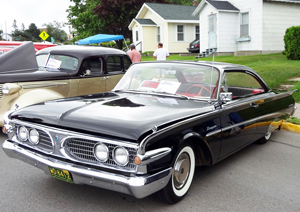 Early in the 1960s, American automotive styling turned away from the excesses of the 1950s and took a sharp turn toward more conservative shapes which featured crisper, cleaner styling. Fins disappeared in lieu of tapered rear fenders and trunks. Flatter and wider tail lights integrated into the rear clip replaced bullet-shaped ones protruding from the rear of the vehicle like flame trails from a jet engine. Hood surfaces became almost perfectly flat across with minimal topographical features – somewhat boring to look at from the driver’s seat.
Early in the 1960s, American automotive styling turned away from the excesses of the 1950s and took a sharp turn toward more conservative shapes which featured crisper, cleaner styling. Fins disappeared in lieu of tapered rear fenders and trunks. Flatter and wider tail lights integrated into the rear clip replaced bullet-shaped ones protruding from the rear of the vehicle like flame trails from a jet engine. Hood surfaces became almost perfectly flat across with minimal topographical features – somewhat boring to look at from the driver’s seat.
(Note: A slide show with full-size pictures of 1960s vehicles we found notable is at the end of this article.)
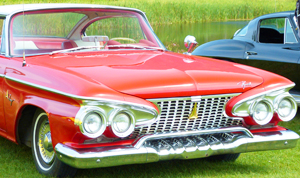 It is interesting to look at the slightly stranger styling Chrysler brands such as Dodge, DeSoto, and Plymouth created for 1961 with strangely angled headlights, grilles and roof line shapes because General Motors and Ford designs stayed step in step with each other during this time.
It is interesting to look at the slightly stranger styling Chrysler brands such as Dodge, DeSoto, and Plymouth created for 1961 with strangely angled headlights, grilles and roof line shapes because General Motors and Ford designs stayed step in step with each other during this time.
 As well as being almost indistinguishable from each other (see the 1991 movie “My Cousin Vinny”), the ’61 Buick Skylark and Pontiac Tempest were very similar in shape and size to the ’61 Ford Falcon. After tracing the shapes of a Falcon and a Buick Skylark, it was difficult to distinguish one from the other.
As well as being almost indistinguishable from each other (see the 1991 movie “My Cousin Vinny”), the ’61 Buick Skylark and Pontiac Tempest were very similar in shape and size to the ’61 Ford Falcon. After tracing the shapes of a Falcon and a Buick Skylark, it was difficult to distinguish one from the other.
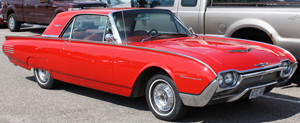 Only when looking at the shape of the Falcon wheel well openings does one begin to see a family resemblance to larger, more luxurious Lincolns, T-Birds and Galaxie models. It was our feeling that this most basic, common model Ford barely distinguishes itself from competition and from other Fords. However, we gave credit to Ford Motor Company as a whole for gaining recognizability during this decade because the 1961 Lincoln Continental and Thunderbird were such distinctive shapes in their own right.
Only when looking at the shape of the Falcon wheel well openings does one begin to see a family resemblance to larger, more luxurious Lincolns, T-Birds and Galaxie models. It was our feeling that this most basic, common model Ford barely distinguishes itself from competition and from other Fords. However, we gave credit to Ford Motor Company as a whole for gaining recognizability during this decade because the 1961 Lincoln Continental and Thunderbird were such distinctive shapes in their own right.
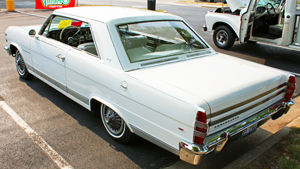 Another good example of styling similarities from this decade is noticeable after comparing a 1966 AMC Ambassador coupe to a 1965 Buick Special, Chevy Nova, Plymouth Belvedere, or Ford Fairlaine. Crisp, clean styling, yes – but try to tell their shapes apart on tracing paper.
Another good example of styling similarities from this decade is noticeable after comparing a 1966 AMC Ambassador coupe to a 1965 Buick Special, Chevy Nova, Plymouth Belvedere, or Ford Fairlaine. Crisp, clean styling, yes – but try to tell their shapes apart on tracing paper.
 From what can be seen at quick glance, the midsize Buick Special is highly derivative of full-size 1964 Buicks and Oldsmobiles with similar overall contours and wheel openings. Mid-1960s full size Chryslers also have some of the same proportions, but are very difficult to tell when using the tracing paper. It isn’t easy to tell a 1968 Chrysler 300 from a 1966 Buick Wildcat.
From what can be seen at quick glance, the midsize Buick Special is highly derivative of full-size 1964 Buicks and Oldsmobiles with similar overall contours and wheel openings. Mid-1960s full size Chryslers also have some of the same proportions, but are very difficult to tell when using the tracing paper. It isn’t easy to tell a 1968 Chrysler 300 from a 1966 Buick Wildcat.
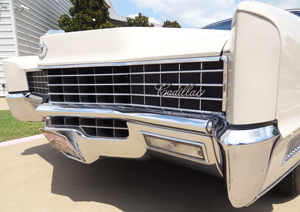 One of my favorite design trends was headlights concealed behind retracting covers camouflaged with grille designs. I consider this late-‘60s era the beginning of the “modern” classic car. But because grille-concealed headlamps were used on at least one version (and often more) high-end or performance model from every single American make during 1967-68, we ruled it did nothing to create additional recognizability.
One of my favorite design trends was headlights concealed behind retracting covers camouflaged with grille designs. I consider this late-‘60s era the beginning of the “modern” classic car. But because grille-concealed headlamps were used on at least one version (and often more) high-end or performance model from every single American make during 1967-68, we ruled it did nothing to create additional recognizability.
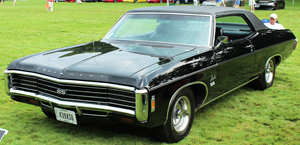 By 1970, most grill-concealed headlights disappeared but it wasn’t long before designers sought similar gee-whiz effects with painted headlamp covers in the 1970s – and later pop up headlamps in the 1980s. But to us, few vehicles from this decade are cooler-looking than the front of a 1967 or ’68 Cadillac Eldorado.
By 1970, most grill-concealed headlights disappeared but it wasn’t long before designers sought similar gee-whiz effects with painted headlamp covers in the 1970s – and later pop up headlamps in the 1980s. But to us, few vehicles from this decade are cooler-looking than the front of a 1967 or ’68 Cadillac Eldorado.
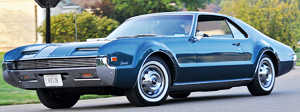 Another interesting look of the “sign of the times” 1960s was the 1966-70 Olds Toronado and Buick Riviera – original designs which inspired the 1968-72 Chevrolet Chevelle, Oldsmobile Cutlass Supreme, and other GM A-bodies. The unique arc of the roof, trunk and C-pillars along with an absence of belt lines served to all these vehicles look like they were going fast even while sitting still in an Apollo 13 fashion.
Another interesting look of the “sign of the times” 1960s was the 1966-70 Olds Toronado and Buick Riviera – original designs which inspired the 1968-72 Chevrolet Chevelle, Oldsmobile Cutlass Supreme, and other GM A-bodies. The unique arc of the roof, trunk and C-pillars along with an absence of belt lines served to all these vehicles look like they were going fast even while sitting still in an Apollo 13 fashion.
Also contributing flair and uniqueness to the decade were the 1965 Olds 88 and the derivatively smaller 1966-67 Olds Cutlass.
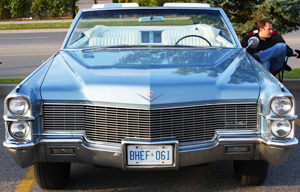 An important trend that emerged during the decade was a return of contours to the shape of hoods. Perhaps inspired by Rolls Royce Silver Clouds of the period, Cadillac first borrowed the “boat-prow” look on its 1965 de Villes and 1967 Eldorado. A slight “bulge-up” on the hood began at full width by the windshield, then tapered as it ran down the length of the hood until it reached a narrow point at the front. Blade-like front fenders rose up on each side to frame the edges of the hood and return the luxury land-yacht feel of the 1940s.
An important trend that emerged during the decade was a return of contours to the shape of hoods. Perhaps inspired by Rolls Royce Silver Clouds of the period, Cadillac first borrowed the “boat-prow” look on its 1965 de Villes and 1967 Eldorado. A slight “bulge-up” on the hood began at full width by the windshield, then tapered as it ran down the length of the hood until it reached a narrow point at the front. Blade-like front fenders rose up on each side to frame the edges of the hood and return the luxury land-yacht feel of the 1940s.
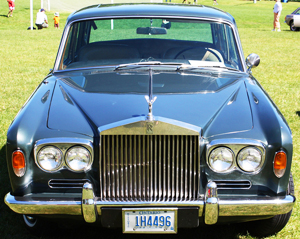 The 1965 Rolls-Royce Silver Shadow created a more modern interpretation of the look – inspiring the 1969 Lincoln Mark III and other Lincolns for two decades to come with a tall waterfall grille design. The 1967-70 Eldorado served up unique styling of a different flavor that’s still distinctive today. None of us had trouble recognizing Cadillacs of this decade.
The 1965 Rolls-Royce Silver Shadow created a more modern interpretation of the look – inspiring the 1969 Lincoln Mark III and other Lincolns for two decades to come with a tall waterfall grille design. The 1967-70 Eldorado served up unique styling of a different flavor that’s still distinctive today. None of us had trouble recognizing Cadillacs of this decade.
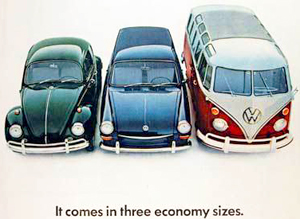 The continued growth of import brands in the 1960s such as Volkswagen, Mercedes, Porsche, Jaguar, MG, Fiat, and Ferrari among others made for even greater differentiation of cars to the naked eye. While Japanese brands were still not a large factor until the following decade, the European offerings were very recognizable, had unique shapes, and were easy to spot in a crowd.
The continued growth of import brands in the 1960s such as Volkswagen, Mercedes, Porsche, Jaguar, MG, Fiat, and Ferrari among others made for even greater differentiation of cars to the naked eye. While Japanese brands were still not a large factor until the following decade, the European offerings were very recognizable, had unique shapes, and were easy to spot in a crowd.
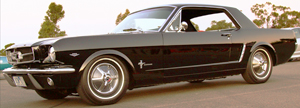 American models new to this decade such as the 1964 Mustang, the 1967 Camaro/Firebird and the 1969 Dodge Charger all had unique lines. Finally, we all agreed this was the first entire decade that pickup trucks looked completely different from cars on all sides.
American models new to this decade such as the 1964 Mustang, the 1967 Camaro/Firebird and the 1969 Dodge Charger all had unique lines. Finally, we all agreed this was the first entire decade that pickup trucks looked completely different from cars on all sides.
The decision now went to the 1960s as the winning decade.
CLICK ON ANY OF THE PICTURES BELOW TO EXPAND TO FULL SIZE. USE BACK ARROW TO RETURN HERE, OR SCROLL THROUGH THE PICTURES USING SMALL ARROWS UNDERNEATH EACH PICTURE.
- Attempting to resolve a debate with my mother that cars from the late 1940s and ’50s on any given street were more recognizable than now, I take a look at some of the more popular design trends during different decades. This installment looks and car models sold during the 1960s in the United States.
- The new-for-1960 Chevrolet Corvair in the foreground is an example of how American automotive styling turned away from the excesses of the 1950s and took a sharp turn toward more conservative shapes. With crisper, cleaner styling, fins disappeared in lieu of tapered rear fenders and trunks.
- Designs of the early 1960s (1960 Edsel Ranger shown) featured hood surfaces that were almost perfectly flat across with minimal topographical features. Flatter and wider tail lights integrated into the rear clip replaced bullet-shaped ones protruding from the rear of the vehicle like flame trails from a jet engine.
- It is interesting to look at the slightly stranger styling Chrysler brands such as Dodge, DeSoto, and Plymouth created for 1961 with strangely angled headlights, grilles and roofline shapes. Here, a 1961 DeSoto Fireflite is shown.
- Plymouth’s version of Chrysler’s full-size cars adopted a bizarre and uniquely recognizable front end – a far cry from the 1958 version featured in the movie “Christine.”
- A close up view of the odd styling found on the 1962 Dodge Dart.
- Overall, we gave Chrysler Corporation offerings credit for adding to vehicle recognizability for the decade as a whole. During this same time, General Motors and Ford designs stayed step in step with each other.
- On tracing paper, we found it hard to tell any difference in size and shape between a 1961 Ford Falcon (shown), Pontiac Tempest, and Buick Skylark.
- 1961 Pontiac Tempest
- Only when looking at the shape of the Falcon wheel well openings does one begin to see a family resemblance to larger, more luxurious Lincolns, T-Birds and Galaxie models.
- The 1960 Ford Sunliner convertible is almost a dead ringer for a 1960 Edsel.
- However, we gave credit to Ford Motor Company as a whole for gaining recognizability during this decade because the 1961 Lincoln Continental and Thunderbird were such distinctive shapes in their own right.
- It’s hard to argue the 1963-65 Buick Riviera created an instantly recognizable profile that helped the decade as a whole. Originally, this model was planned as a Cadillac.
- Another good example of styling similarities from this decade is noticeable after comparing a 1965 Chevrolet Nova to a similar vintage AMC Ambassador coupe, 1965 Buick Special, Plymouth Belvidere, or Ford Fairlaine.
- 1965 Ford Falcon
- 1966 AMC Ambassador
- Stacked headlights were another styling favorite of 1960s automotive designers. 1966 AMC Ambassador shown.
- We felt the long hood, long trunk, and short passenger compartment of the 1964-67 Pontiac GTO gave it a recognizable profile. Its handsome design made it a standout to look at also. (1967 model shown)
- Full-size Oldsmobiles and Buicks from 1964 on featured very clean styling. While they may look similar to each other, they both were distinctively GM.
- 1964 Buick Electra hardtop sedan.
- From what can be seen at quick glance, the midsize Buick Special of 1965 is highly derivative of full-size 1964 Buicks and Oldsmobiles in the previous two pics. Overall contours and wheel openings are similar.
- An important trend that emerged during the decade was a return of contours to the shape of hoods. Perhaps inspired by Rolls Royce Silver Clouds of the period, Cadillac first borrowed the “boat-prow” look on its 1965 DeVille shown here.
- The 1965 Rolls-Royce Silver Shadow created a more modern interpretation of the look – inspiring the 1969 Lincoln Mark III and other Lincolns for two decades to come with a tall waterfall grille design. (1966 model shown)
- “Boat prow” hood contouring is defined by a slight “bulge-up” on the hood beginning at full width by the windshield. It then tapers as it runs down the length of the hood until it reaches a narrow point at the front. Blade-like front fenders rise up on each side to frame the edges of the hood and return the luxury land-yacht feel of the 1940s.
- Lincoln was inspired by the proportions of the 1967 Cadillac Eldorado to create it’s own personal luxury coupe, the 1968-71 Mark III. This marked Lincoln’s return to boat prow hood styling that would continue for over 20 years.
- A closer look at a 1968 Lincoln Mark III. We felt this design added to overall vehicle recognizability for the 1960s.
- Also contributing flair and uniqueness to the decade were the 1965 Olds 88 and the derivatively smaller 1966-67 Olds Cutlass.
- 1965 Oldsmobile Delta 88 coupe.
- While the 1966 mid-size Olds Cutlass looks similar in profile to the 1965 Delta 88, it is uniquely recognizable – even today.
- The full-size Buick Wildcat coupe of 1966 has some of the same proportions as mid-size GM offerings.
- On tracing paper, full-size Chryslers from 1967-68 are hard to tell apart from a 1966 Buick Wildcat.
- 1966 Buick Wildcat, front quarter view
- 1968 Chrysler 300 coupe, front quarter view.
- Another interesting look of the later 1960s was the 1966-70 Olds Toronado and Buick Riviera – original designs which inspired the 1968-72 Chevrolet Chevelle, Oldsmobile Cutlass Supreme, and other GM A-bodies.
- We like the look this owner has given their 1966 Oldsmobile Toronado.
- The unique arc of the roof, trunk and C-pillars along with an absence of belt lines on the Toronado also worked well on the mid-size 1968 Oldsmobile Cutlass. Some say they look like they are going fast even while sitting still.
- One of our favorite design trends was headlights concealed behind retracting covers camouflaged with grille designs. I consider this late-‘60s era the beginning of the “modern” classic car.
- By 1970, most grill-concealed headlights disappeared but it wasn’t long before designers sought similar gee-whiz effects with painted headlamp covers in the 1970s – and later pop up headlamps in the 1980s. But to us, few vehicles from this decade are cooler-looking than the front of a 1967 or ’68 Cadillac Eldorado.
- Because grille-concealed headlamps were used on at least one version (and often more) high-end or performance model from every single American make during 1967-68, we ruled it did nothing to create additional recognizability. (Shown: 1969 Chevrolet Impala)
- The growth and popularity of uniquely recognizable Volkswagen models through the entire 1960s added to the decade as a whole.
- This 1960s winter scene from Burlington Vermont is a good example of how Volkswagens could be found everywhere during this decade.
- American models new to this decade such as the 1964 Mustang had unique lines.
- Overall, we felt Mustangs, Camaros, and Dodge Chargers from the 1960s were uniquely recognizable.
- 1968 Chevrolet Camaro, rear quarter view.
- Most 1968-70 Dodge Chargers featured concealed headlights, except base models. (1968 model shown)
- The continued growth of import brands in the 1960s such as Volkswagen, Porsche, Jaguar, MG, Fiat, and Ferrari among others made for even greater differentiation of cars to the naked eye. While Japanese brands were still not a large factor until the following decade, the European offerings were very recognizable, had unique shapes, and were easy to spot in a crowd.
- Mercedes-Benz established a firm foothold in the American luxury car market during the 1960s. They were, and are, highly recognizable.
- Forgotten now, the original Fiat 500 was a common sight during the 1960s.
- 1960s era Porsche 911 and 356 models, shown respectively.
- Small British sports cars such as MG, Triumph, and Austin Healey were popular during the 1960s – adding points for the decade that the 1950s could not match.
- The 1961-74 Jaguar XKE (1966 model shown) was unmistakeable, and it still is today.

